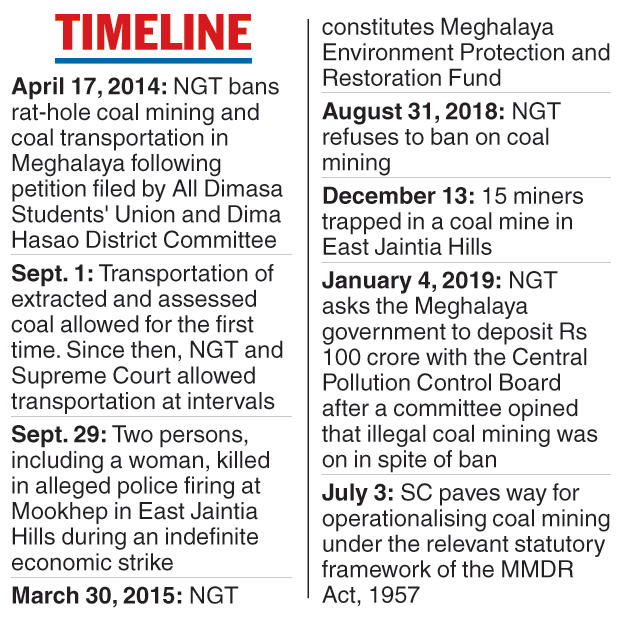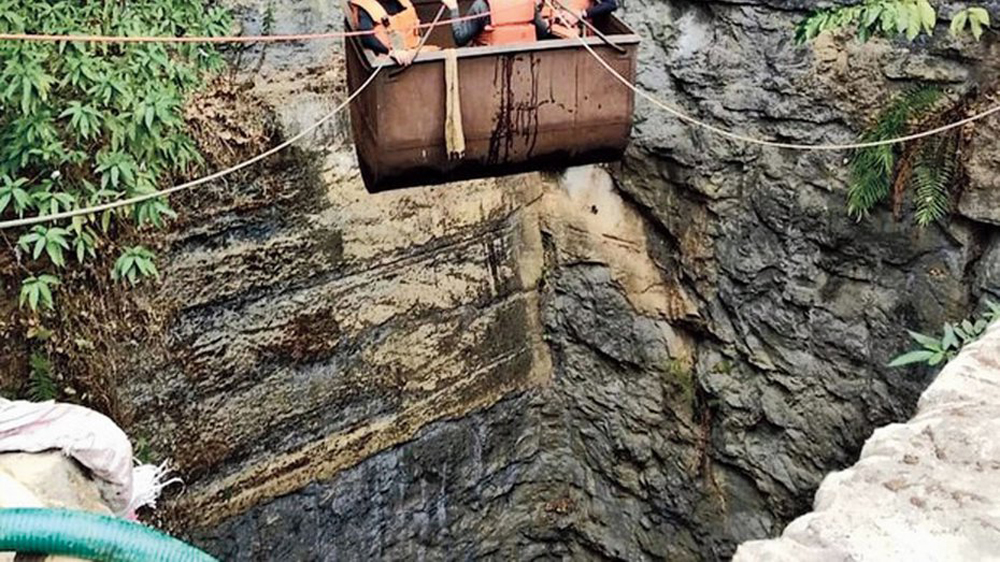The Supreme Court has set aside the ban on coal mining in Meghalaya imposed by the National Green Tribunal (NGT) since April 2014, but ruled that the state would have to enforce mining laws.
The apex court, in a 203-page judgment on Wednesday, made a slew of observations and issued directions to the state.
Delivering the judgment, Justice Ashok Bhushan, with Justice K.M. Joseph in the bench, said: “Natural resources of the country are not meant to be consumed only by the present generation of men or women of the region where natural resources are deposited. These treasures of nature are for all generations to come and for intelligent use of the entire country. The present generation owes a duty to preserve and conserve the natural resources of the nation so that it may be used in the best interest of coming generations as well and for the country as a whole.”
Justice Bhushan noted that the allegations of environmental degradation by illegal and unregulated coal mining “were fully proved” from materials on the record including the report of the experts, report of the Meghalaya State Pollution Control Board, the report of Justice B.P. Katakey committee, which all proved environmental degradation of water, air and surface.
Further, the court noted that the stand taken on behalf of the state of Meghalaya before the apex court that the NGT has no jurisdiction cannot be approved.
“The state government is under constitutional obligation to ensure clean environment to all its citizens. In cases pertaining to environmental matter, the state has to act as facilitator and not as obstructionist,” the judgment noted.
Dwelling on the land tenure system in Meghalaya, the court observed that as per the land tenure system as applicable in the Hills Districts of Meghalaya, most of the land is either privately or community owned in which the state does not claim any right.
The private owners of the land as well as community owners have both the surface right as well as sub-soil rights.
The court noted: “While paragraph 12A sub-clause (b) of Sixth Schedule empowers that the President may, with respect to any act of Parliament, by notification, direct that it shall not apply to an autonomous district or an autonomous region in the state of Meghalaya, or shall apply to such district or region or any part thereof subject to such exceptions or modifications as he may specify in the notification, no notification has been issued by the President.
“There is nothing in Sixth Schedule of the Constitution which may indicate about the inapplicability of (Mines and Minerals (Development and Regulation)) Act, 1957 with regard to the hills sistricts of state of Meghalaya,” the court said.
It also said there is nothing in Section 4(1) of the 1957 Act to indicate that restriction contained in Section 4(1) does not apply with regard to privately owned/community owned land in Hills Districts of Meghalaya.
The court said the word ‘any area’ under Section 4(1) also has significance which does not have any exception. Further, the phrase “except under and in accordance with terms and condition with a mining lease granted under the Act,” is also significant, which makes the intent and purpose of prohibition clear and loud.
Moreover, the court said that the statutory scheme delineated by Section 13(2)(f) and the Minerals (Concession) Rules, 1960 clearly contemplate grant of mining lease, with regard to both the categories of land, that is, land in which minerals vest in the Government, and the land in which minerals vest in a person other than the Government.
The judgement also noted that the Mines Act, 1952 contains various provisions regarding inspection of mining operation and management of mines.
“The provisions of The Mines Act, 1952 are mandatory to be followed before working a mine. The regulations, namely Coal Mines Regulations, 2017, also contains several regulatory provisions which need to be followed while working a mine by a mining lease holder. The enforcement of Mines Act, 1952 and the Regulations, 2017, have to be ensured by the state in the public interest,” the court added.
“While implementing statutory regime for carrying out mining operations in the hills districts of Meghalaya, the state has to ensure compliance of not only MMDR Act, 1957 but Mines Act, 1952 as well as Environment (Protection) Act, 1986,” it said.
The court said that for carrying coal mining operations in privately owned/community owned land, “it is not the state government which shall grant the mining lease under Chapter V of Rules, 1960, but it is the private owner/community owner of the land, who is also the owner of the mineral, who shall grant lease for mining of coal as per provisions of Chapter V of Rules, 1960,” after obtaining previous approval of the central government through the state government.

The Telegraph
In the event of mining being carried out by a mining lease- holder as per the provisions of Act, 1957 and Rules, 1960 with an approved mining plan, there can be no objections in carrying of such mining operations under the regulation and control of the state of Meghalaya.
“We clarify that in event mining operations are undertaken in privately owned/community owned land in hill districts of Meghalaya in accordance with mining lease with approved mining plan as per Act, 1957 and Mineral Concessions Rule, 1960, the ban order dated 17.04.2014 of the tribunal of the NGT shall not come in way of carrying mining operations,” it noted.
Moreover, on the order of the NGT to the state government to deposit Rs 100 crore with the Central Pollution Control Board, the court accepted the submissions that “the state has very limited source of finances” and putting an extra burden on Meghalaya to make payment of Rs 100 crore from its own financial resources may cause great hardship to the state.
“Ends of justice be served in modifying the direction of NGT to the extent that state is permitted to transfer an amount of Rs 100 crore from the amount lying in the Meghalaya Environment Protection and Restoration Fund (MEPRF) to the Central Pollution Control Board. The Central Pollution Control Board as directed by the Tribunal shall utilize the aforesaid amount of Rs 100 crore only for restoration of the environment in the state of Meghalaya,” the court said.
Further, the court directed that the coal which has been extracted and lying in open after May 15, 2016 does not automatically vest in the state and the owner of the coal or the person who has mined the coal shall have the proprietary right in the mineral.
“The state, having carried out the assessment of the coal lying in four districts, including the details of the quantities and the details of owners being available with it, it may ensure that entire coal is handed over to the Coal India Ltd, as per the mode and manner to be formulated by Katakey Committee in consultation with officers of the Coal India Ltd and the state of Meghalaya,” it said.
On the coal which has been seized by the state in illegal transportation and illegal mining for which different cases have been registered by the state, the court directed that the seized coal shall be dealt by the state in accordance with Section 21 of the MMDR Act, 1957 and on being satisfied, the state can take a decision to recover the entire quantity of coal so illegally raised without lawful authority.
It also said that all extracted coal, as assessed by the state and lying in different districts as per order of NGT is in custody of the state government and will have to be handed over to Coal India Ltd for proper disposal.










